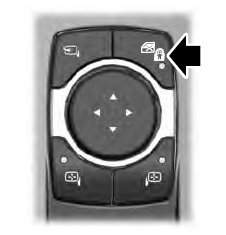Lincoln Aviator: Brake System - General Information / General Procedures - Brake Service Mode Activation and Deactivation
Activation
.jpg) WARNING:
Service actions on vehicles equipped with electronic parking
brakes may cause unexpected parking brake application, which could
result in injury to hands or fingers. Put the electronic parking brake
system into service mode prior to servicing or removing rear brake
components. Failure to follow this instruction may result in serious
personal injury.
WARNING:
Service actions on vehicles equipped with electronic parking
brakes may cause unexpected parking brake application, which could
result in injury to hands or fingers. Put the electronic parking brake
system into service mode prior to servicing or removing rear brake
components. Failure to follow this instruction may result in serious
personal injury.
.jpg) WARNING:
Service actions on vehicles equipped with electronic brake
booster without activating the brake system service mode may result in
unexpected hydraulic brake application or a false leak detection DTC.
This will significantly reduce the performance of the brake system.
Failure to follow this instruction may result in serious personal
injury.
WARNING:
Service actions on vehicles equipped with electronic brake
booster without activating the brake system service mode may result in
unexpected hydraulic brake application or a false leak detection DTC.
This will significantly reduce the performance of the brake system.
Failure to follow this instruction may result in serious personal
injury.
NOTE: Brake service mode is also known as brake maintenance mode.
NOTE: Prior to carrying out the brake service mode activation steps below, clear all EPB and EBB related DTC's.
NOTE: Carry out the following service mode activation procedure to deactivate the EPB and EBB systems. The EPB and EBB system can also be deactivated using the diagnostic scan tool and following the on-screen instructions.
NOTE: This mode is required to deactivate the brake boost and to allow the entire brake system to be bleed manually.
NOTE: This mode will cause all the associated brake warning indicators and text messages to appear.
-
Set the ignition to ON.
-
Release the EPB.
-
Press and hold the accelerator pedal and place the EPB switch to the RELEASE (downward) position. Continue to hold the accelerator pedal and EPB switch.
-
Set the ignition to OFF then set the ignition to ON within 5 seconds. Continue to hold the accelerator pedal and the EPB switch.
-
Set the ignition to OFF then release the accelerator pedal and EPB switch.
-
NOTE: The brake system will be deactivated, preventing brake application until service has been completed and service mode has been deactivated. The yellow EPB indicator will be illuminated and Maintenance Mode will display on the message center.
-
NOTE: When replacing brake pads in service mode, the brake caliper piston must be compressed into the caliper housing. The brake caliper piston does not have to be rotated while compressing the piston.
-
Deactivation
NOTICE: The brake system performance will be significantly reduced when the brake system is put in service mode.
NOTE: Carry out the following Brake Maintenance Mode deactivation procedure to activate the EBB and EPB systems. These systems can also be activated using the diagnostic scan tool and following the on-screen instructions.
-
Set the ignition to ON.
-
Press and hold the accelerator pedal.
-
Place the EPB switch in the APPLY (upward) position. Continue to hold the accelerator pedal and the EPB switch.
-
Firmly press the brake pedal for at least 1 second.
Release the brake pedal while continuing to hold the accelerator pedal
and the EPB switch.
-
Set the ignition to OFF then set the ignition to ON
within 5 seconds, then release the accelerator pedal and the EPB switch.
-
NOTE: Once the ignition is set to ON, the EPB system will immediately apply and release the parking brake to guarantee sufficient air gap between the rear brake pads and brake disc. If the EPB switch is not released prior to completion of this sequence, it will apply the EPB. The EPB will have to released prior to moving the vehicle.
-
NOTE: When Brake Maintenance Mode is deactivated, the Yellow Parking Brake and Red Brake Warning Indicators turn off and "Brake Maintenance Mode" no longer displays in the message center.
-
 General Procedures - Brake Disc Machining
General Procedures - Brake Disc Machining
Repair
NOTE:
On-Vehicle Brake Lathe Training Videos
Vehicle preparation.
Click here to view a video version of this procedure...
Other information:
Lincoln Aviator 2020-2026 Owners Manual: Passenger Compartment Fuse Panel
T..
Lincoln Aviator 2020-2026 Service Manual: Description and Operation - Power Brake System - System Operation and Component Description
System Operation System Diagram - Electric Brake Boost E347819 *.sttxt { visibility: hidden; } *.stcallout { visibility: visible; } HS-CAN3 HS-CAN1 HS-CAN2 1 IPC 2 RCM 3 BCM 4 PCM 5 GWM 6 ABS/EBB 7 Wheel speed sensors 8 Brake pedal Item Description 1 IPC 2 RCM 3 BCM 4 PCM 5 GWM 6 ABS/ EBB 7 Wheel speed sensors 8 Brake pedal Network Message Chart Module Network Input Messages - ABS Module Broadcast Message Originating Module Message Purpose Accelerator pedal position PCM This message is first sent to the GWM and then to the ABS module...
Categories
- Manuals Home
- Lincoln Aviator Owners Manual
- Lincoln Aviator Service Manual
- Description and Operation - Jacking and Lifting
- Anti-Theft Alarm
- Opening and Closing the Hood
- New on site
- Most important about car
Child Safety Locks
When the child safety locks are set, you cannot open the rear doors from the inside.

The child safety lock control is on the driver door.
Press the control to switch the child safety locks on. Press the control again to switch them off. A light on the child safety control illuminates when you switch them on.

